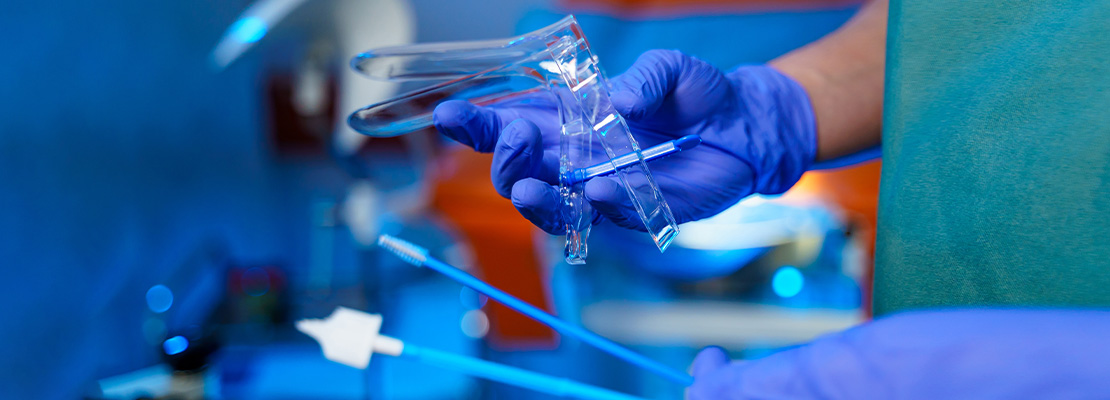Answering 6 Common Questions About Pap Tests

January is the awareness month for cervical cancer, which the World Health Organization reports is the fourth most common type of cancer worldwide among people with cervixes. The Centers for Disease Control and Prevention estimates that each year, about 13,000 new cases of cervical cancer are diagnosed in the US, and about 4,000 of these patients die from the disease.
Fortunately, we have a means for early detection and prevention. A Pap test, also known as a Pap smear, is a minimally invasive way of testing for cervical cancer. This article addresses some common questions and misconceptions about Pap tests.
What does a Pap test entail?
The testing process involves collecting cells from the cervix, which sits at the junction of the lower part of the uterus and the top of the vagina. The goal of a Pap test is to diagnose cervical cancer early, giving the patient the best chance for a cure. A Pap smear can also detect cell abnormalities that, left unchecked, would likely develop into cervical cancer.
To perform a Pap test, your gynecologist needs to get a sample of cervical cells for laboratory testing by a pathologist. To obtain the tissue for testing, your doctor will likely use a small brush or spatula to scrape a tissue sample from the cervix. The collection process generally only takes a few minutes.
After the sample is collected, your gynecologist will send it to the laboratory for processing and testing by a pathologist, who is a medical doctor trained in the diagnosis of disease.
Why is it sometimes painful or uncomfortable to get a Pap smear specimen?
How is the sample diagnosed?
What are the different types of Pap test results, and what do they mean?
- Atypical
- Low grade
- High grade
- Carcinoma in situ
- Carcinoma
If you receive a test with “atypical squamous cells” (ASC) or “atypical glandular cells,” this means that some abnormal changes were seen in your cells, but not enough to make a definitive diagnosis of cancer or even pre-cancer. This result is not definitive and requires further testing. Your doctor may recommend repeating the Pap smear and/or performing a colposcopy to obtain more information.
A result of low-grade intraepithelial lesion (LSIL), high-grade intraepithelial lesion (HSIL), or adenocarcinoma in-situ (AIS) indicates a pre-cancerous process. The severity of these three results can vary, but in general, they can develop into cervical cancer over time if left untreated. Pap tests are designed to detect pre-cancerous diseases of the cervix, most often caused by HPV.
With an LSIL, the risk of developing cancer is still low, but your doctor may recommend performing a second test. The risk of cancer is higher with an HSIL result. Your doctor will discuss possible treatment options with you to remove the lesion; these procedures typically have a short recovery period.
A cancer result requires immediate treatment and underscores the importance of testing for cervical cancer. The slow-to-develop nature of the disease means it can often be effectively treated and cured—if caught early with regular testing. The following are common types of cancer affecting the cervix:
- Squamous cell carcinoma
- Adenocarcinoma
- Endocervical carcinoma in situ
- Other types of malignant neoplasms
Rarely, the results of a Pap test might be described as inadequate (as mentioned earlier). This means that the pathologist examining your sample could not reach a diagnosis based on the tissue received. This might be due to a small number of cells, poor cell preservation, obstructing elements such as blood, and tissue processing errors. A repeat Pap test is usually performed when the result is inadequate.
How often should I get a Pap test?
We now know that cervical cancer takes many years to develop. With the implementation of the Pap smear reporting system and broader use of HPV testing, guidelines for testing and follow-up have been refined as we learn more about the process. The goal of screening tests is to catch pre-cancerous changes while minimizing over-treatment or unnecessary medical procedures.
In the United States, beginning at age 21 and extending through age 29, people with cervixes are now recommended to undergo Pap testing every three years. For those ages 30 to 65, the interval can be lengthened to every five years when a Pap test is combined with HPV testing, or the individual can elect to do HPV testing alone.
Some medical associations and certain countries have begun HPV-only screening, meaning that the HPV test is used as the initial test to screen for cervical cancer instead of the Pap smear. The recommendations for Pap testing and HPV testing may continue to evolve. Your doctor should provide you with updated information as needed.
Why are Pap tests performed during pregnancy?
Pregnant patients are screened according to the same guidelines as non-pregnant patients. That means if you’re due for a Pap test in the year of your pregnancy, your gynecologist will perform one as usual, likely during your first trimester with other preliminary prenatal tests. Your doctor may also recommend doing a smear if you’ve had an abnormal result recently. The procedure is non-invasive and does not harm the fetus or increase risk of miscarriage.
If you receive an abnormal result from a Pap smear while pregnant, don’t panic. Cervical cancer is a slow-progressing disease, so invasive treatments, if necessary, can usually be postponed until after delivery. Your doctor will likely do more tests and colposcopies to monitor your case during your pregnancy.
Remember, you can always ask to speak to the diagnosing pathologist about your Pap test result if you have any questions.